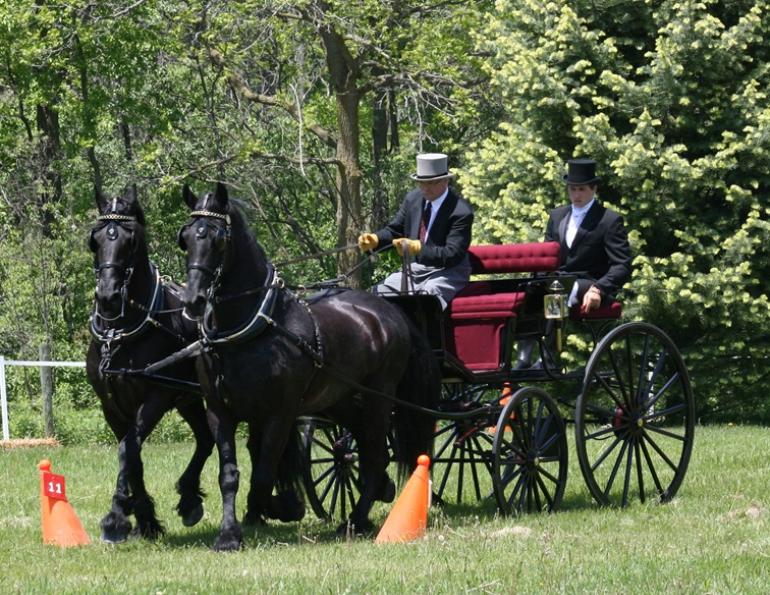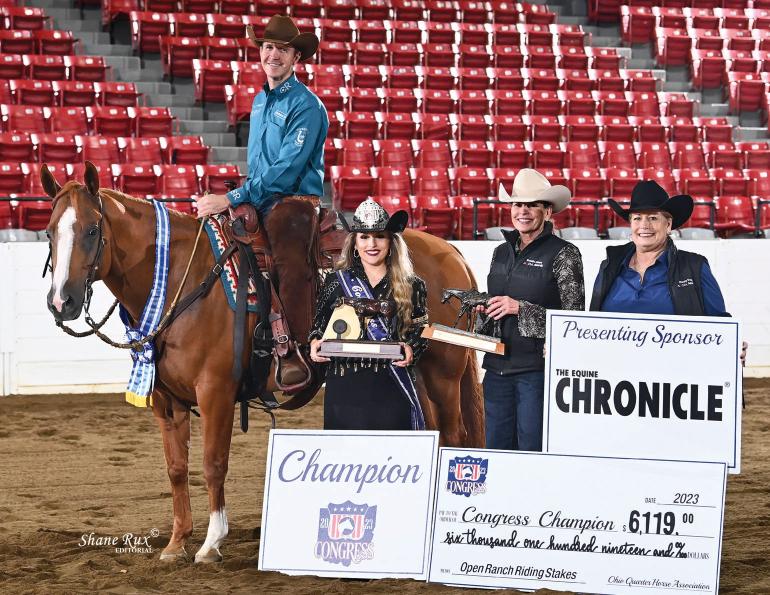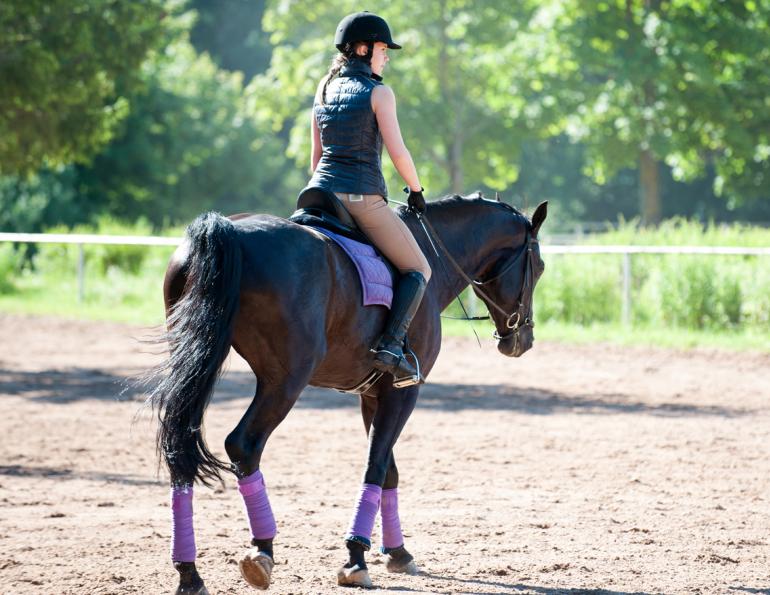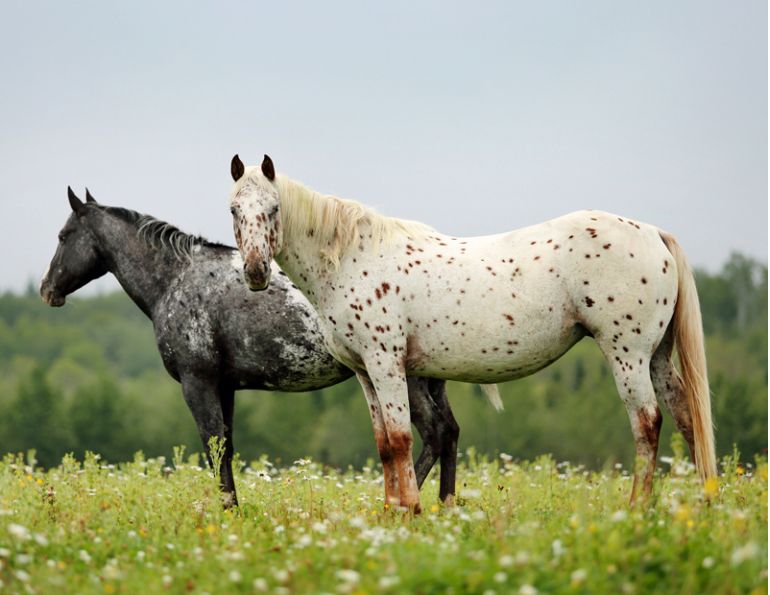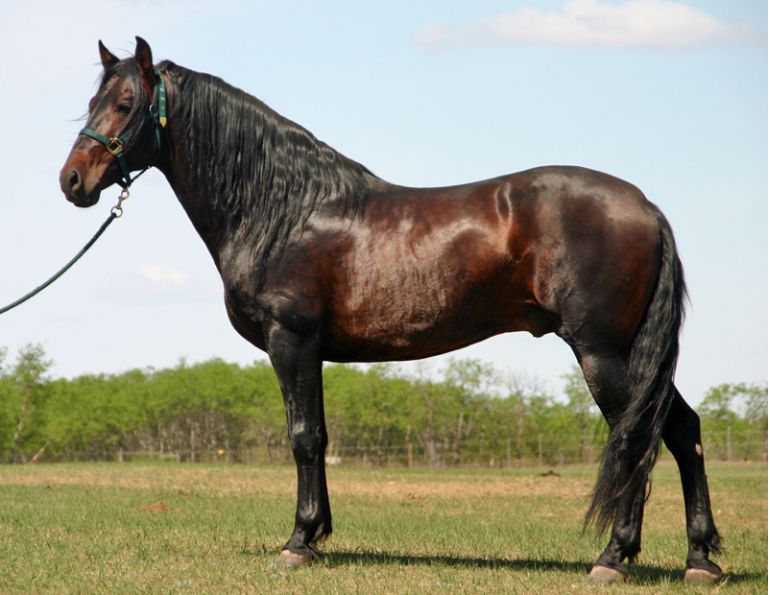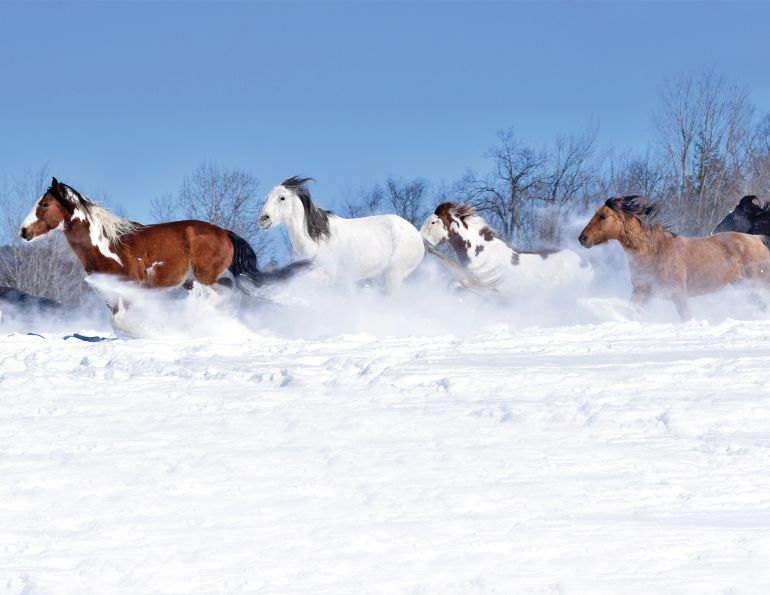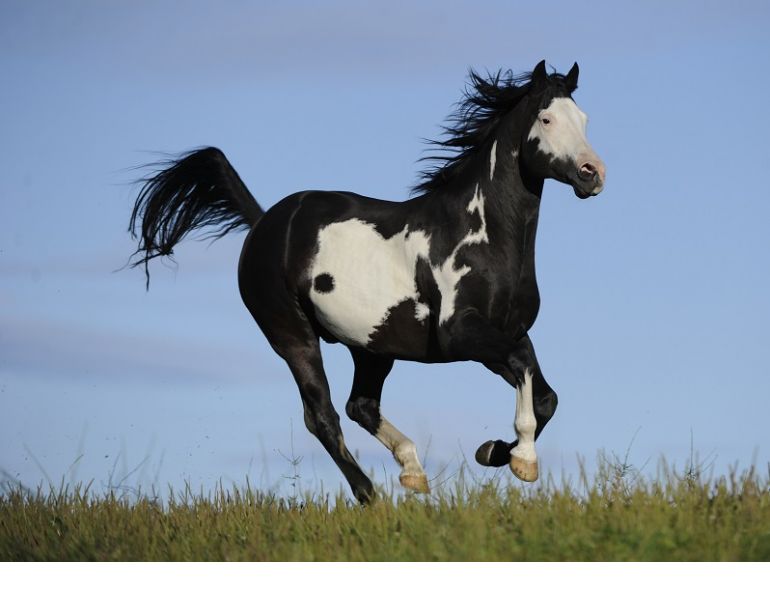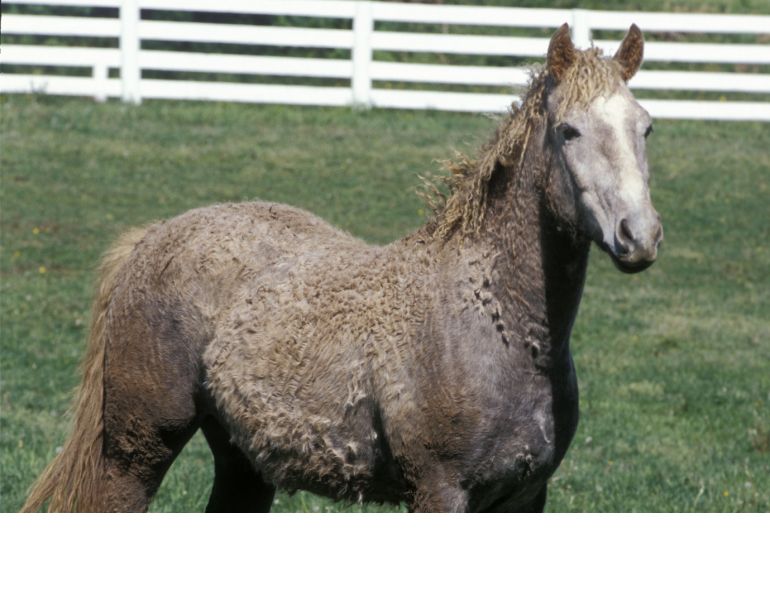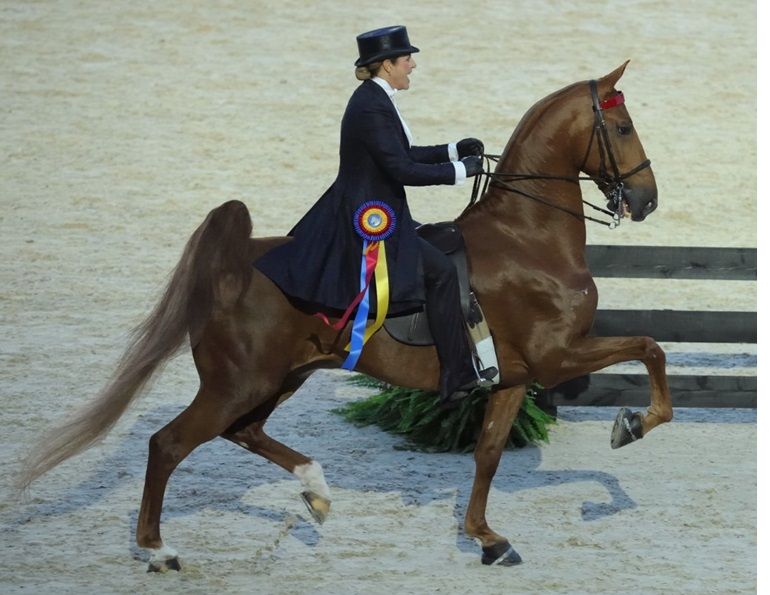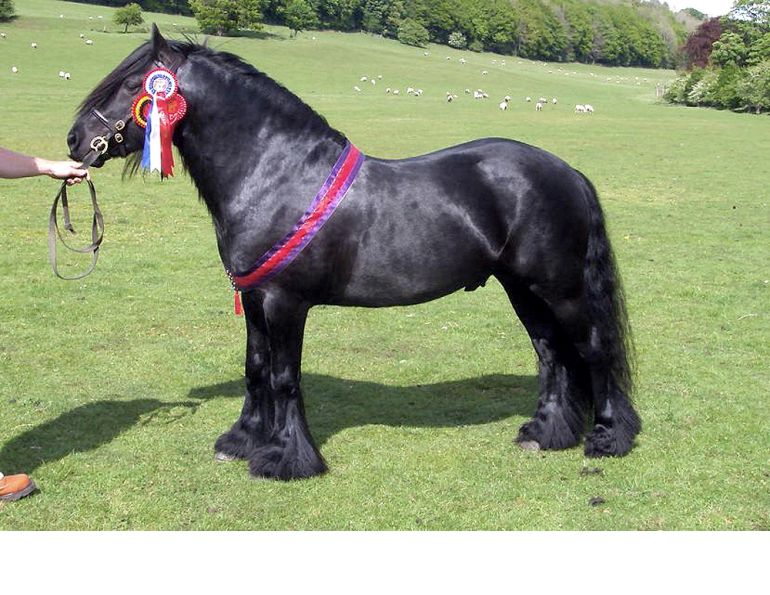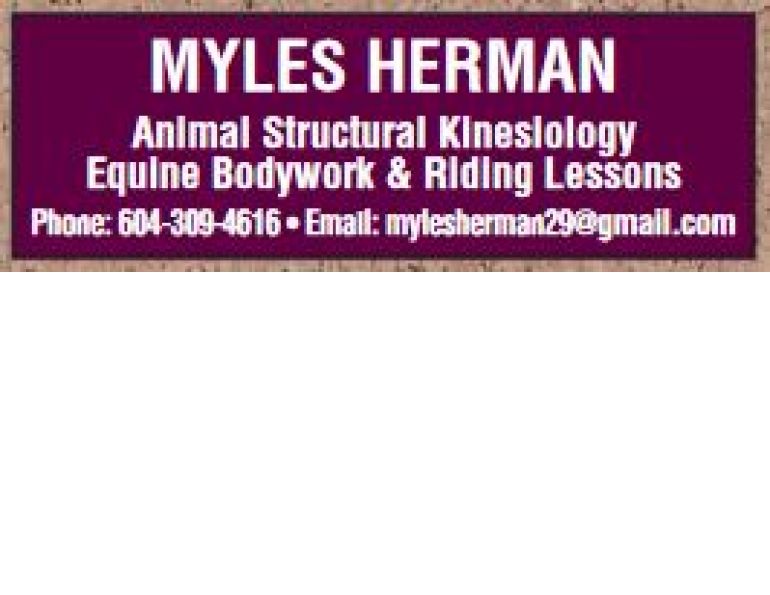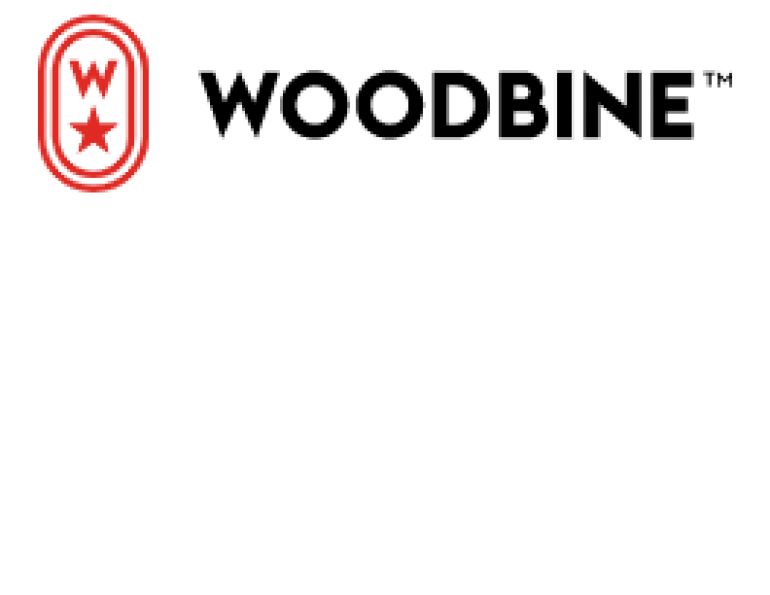The references in this article are relevant to the time it was originally published in 2012.
By Melanie Huggett
See below for article sidebar - Famous Friesians
The Friesian horse’s striking looks, long flowing hair, and expressive gaits make these “Black Pearls” a sight to behold. It is also a horse with a rich history and an endearing temperament. Ask any Friesian enthusiast and they will tell you these horses are creatures of dreams and fantasies.

A purebred Friesian mare, Elkskje S., with her Arabo-Friesian colt by Yk Dark Otto of the Friesian Ranch in Armstrong, BC. Arabo-Friesians are Friesians with added Arabian blood. The goal is a horse that looks and acts like a Friesian, but with increased endurance and toughness. Ideally, Arabo-Friesians have between 6 and 20 percent Arabian blood. Photo: Courtesy of Christiana Pfeifer
Once Upon a Time…
The only breed native to the Netherlands, the Friesian is an ancient, pure Warmblood breed. They developed out of Equus robustus (big horse) in Friesland, the northwestern part of Holland, from where the breed takes its name.
The Friesian has been known across Europe for centuries. The Roman Tacitus (ca 55 to 120) recorded the Friesian’s existence. The breed was used by Frisian soldiers who assisted the Roman legions in Britain.
English writer Anthony Dent wrote about the presence of Frisian troops and their horses at Carlisle, England. Dent and others indicate the Friesian influenced several English breeds, including the Dales and Fell Ponies, the Old English Black, and the Shire. Friesians have a long history as cavalry horses in war.
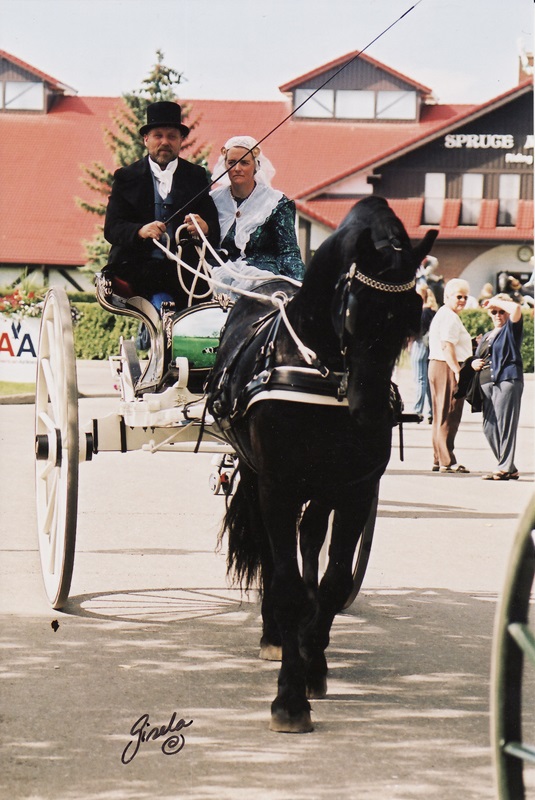
Sietse fan Bonnie View of Bonnie View Farm in Nobleford, Alberta pulls an original Friesian sjees at Spruce Meadows in Calgary, Alberta. Photo: Courtesy of Klaas Wiersma
During the Middle Ages they were used by knights in armour, who prized them for their courage, athleticism, and durability. In the 11th century, William the Conqueror used horses that had a remarkable resemblance to the Friesian.
The breed was also widely used during the Crusades. Hungarian King Louis II rode a Friesian on the battlefield as he rode against the Turks on June 15, 1526.
When Spain occupied the Netherlands during the 80 Year’s War in the 1500’s, they brought many of their own horses.
The modern Friesian was developed through this introduction of Andalusian and Arabian blood from the Spanish horses, giving the Friesian its arched neck, small ears, and high stepping gait.
An announcement in 1544 that German Elector Johann Friedrich von Sachsen came to the Reichstag in Spiers riding a Friesian stallion is the first written evidence of the use of the name “Friesian.”
In 1547, Emperor Charles V recognized Friedrich von Sachsen as he rode in the Battle of Muhlberg on the same stallion.
A particularly famous etching by Stradanus in 1568 shows a Friesian stallion in the stables of Austria’s Don Juan.
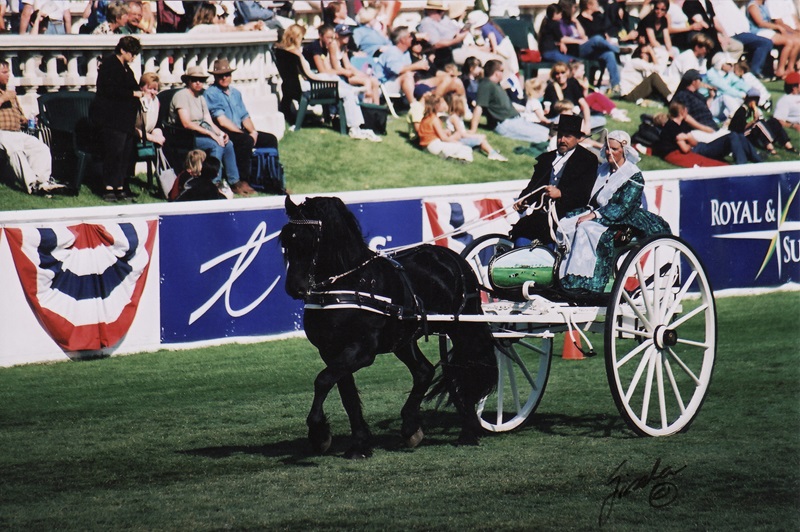
Sietse fan Bonnie View of Bonnie View Farm in Nobleford, Alberta pulls an original Friesian sjees at Spruce Meadows in Calgary, Alberta. Photo: Courtesy of Klaas Wiersma
The 1600s marked the Friesian’s first steps onto North American soil.
Frisian Peter Stuyvesant imported Friesian horses to New Amsterdam (later renamed New York) in 1625.
However, when the Dutch gave up the settlement to the English in 1664, the importations ceased, and crossbreeding drove these early North American Friesians to extinction.
During this brief period in North America, however, the breed became an important influence in the creation of the Morgan breed. Its blood may also have contributed to the Canadian Horse.
At the same time, the Friesian in Europe was being used less as a cavalry mount. Instead they were welcomed at the haut école dressage schools in Paris and Spain and as carriage horses. In the 1700s the Friesian “sjees,” a two-wheeled carriage built in the Rococo style, came into use.
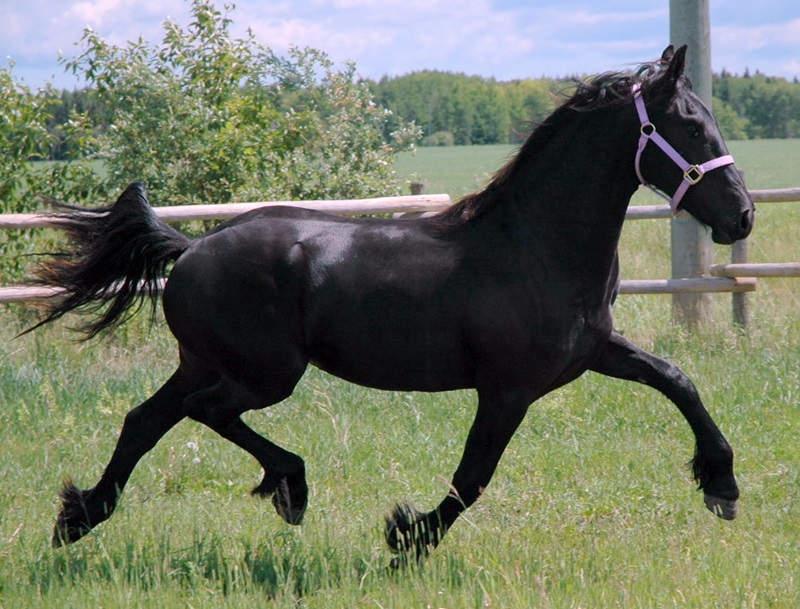
A mare from Raven Oaks Friesians in Onanole, Manitoba shows off the powerful Friesian trot. Photo Courtesy of Sharon Vanderschuit
The Friesian’s trotting ability became famous during the 18th and 19th centuries, when they were used in short distance trotting races. A distance of 325 metres was run under saddle and later in the sjees. In 1823 King William I started a race at Leeuwarden, Holland which became known as the “King’s Golden Whip Day” due to the prize of a golden whip to the winner. This trotting ability caused the breed to be used in the development of new breeds such as the Orlov Trotter and the ancestors of the Hackney breed.
Around the same time that the last King’s Golden Whip Day was run, in 1891 when H.M. Queen Regent Emma awarded the whip for the last time, the popularity of the Friesian horse was beginning to wane. New breeds were faster and able to race for longer distances. Although the first studbook for the Friesian horse in the Netherlands, the Friesch Paarde Stambock (FPS), was created in 1879, the horses’ primary use was now in farming, and the Friesians were less adept at agricultural work than the heavy horse breeds. By 1913, there were only three approved breeding stallions in the studbook.
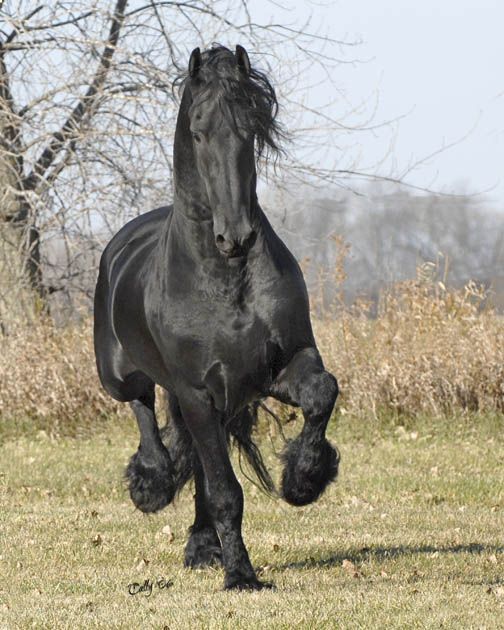
There are now over 80 FPS approved stallions worldwide, with 20 in North America. The FPZV also approves stallions for breeding. Shown is FPS approved stallion Nanning 374. Photo: Courtesy of Jason Tice, FHANA
While this may have meant extinction, a group of dedicated enthusiasts in the Netherlands worked together to save the breed. They bought promising young colts and awarded the best with titles, called “premiums,” which are still given out by the FPS today. Paulus 121, bought in 1916 as a three-year-old, was one of these young stallions and he went on to become the father of all modern Friesian stallions.
The Friesian had somewhat of a revival during the mid-1900s, reclaiming its role as a farm horse. During World War II, German draft horses no longer crossed the border to Holland to work the fields, so the Friesian was bred heavier and shorter to do this work. However, when mechanization increased after the war, the number of Friesians once again dwindled. Once again, only three approved stallions remained: Age 168, Ritske 202, and Tetman 205. From these three stallions and a few hundred mares, all of today’s Friesians descend. Genetic diversity has been strictly managed to ensure the maximum number of bloodlines have survived and inbreeding is at a minimum.
Related: 9 Horse Grooming Tips for Health and Beauty
The Friesian’s second introduction to North America was a permanent one. Thomas Hannon of Canton, Ohio imported Friesians in 1974, 1975, and 1977. More importations followed, along with the creation of American based breeding programs.
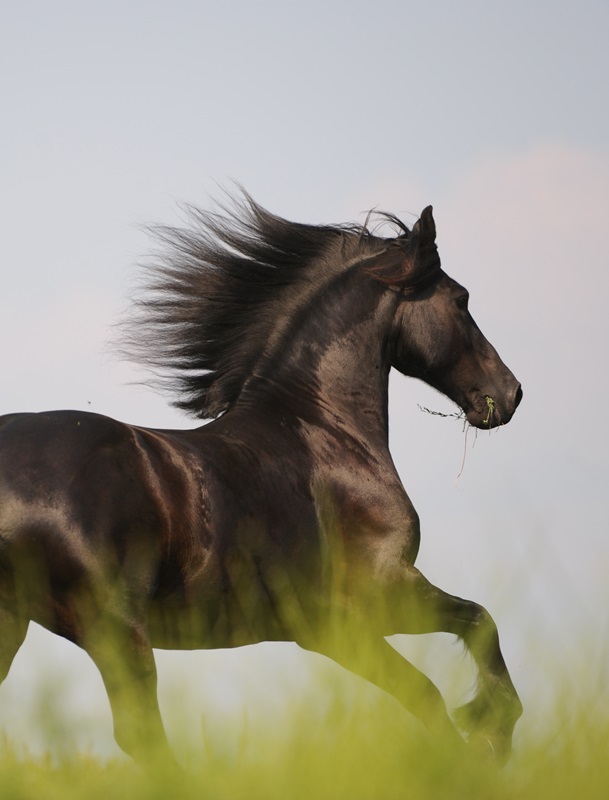
Friesians are often described by their admirers as fantasy horses. Photo: Robin Duncan Photography
Black Beauties
Modern breeding programs have typically focused on two “types” of Friesians: baroque and sport.
“The baroque type is shorter in the back, with more knee action and a more arched neck,” says Ron Steur, who grew up with Friesians in Holland and now trains them at his Three Star Horses in Bridgewater, Virginia.
Baroque Friesians are typically used for driving. The sport type is more fine-boned and athletic, and is often seen doing dressage. Both types, however, have the same overall look.
All Friesians are black. In the past a small number of brown or bay horses existed, but strict selection beginning in the early 1900s eliminated all but the black. White markings are not permitted except for a small star on the forehead.
Their noble heads and long, arching necks are adorned with flowing, luxuriant manes and forelocks, matching their rich tails and thick feathering on the legs, which accentuate their movement.
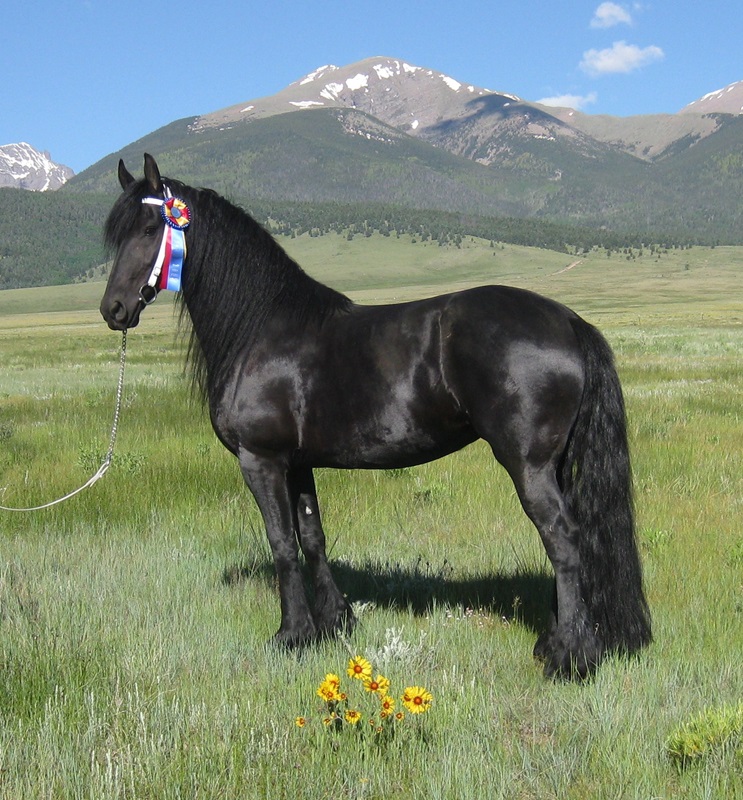
The FPS First Premier Star mare Bente shows good Friesian conformation including a noble head, long, arching neck, strong back and loins, and low set tail. Photo: Courtesy of Alison Gelfand
The eyes are large and expressive, the ears small, with tips pointing slightly towards one another. The neck sits erect on long, sloping shoulders. On average, they stand 15 to 16 hands high. They have a rising build, with strong backs and loins. The croup is long and slightly sloping. It is hard to mistake a Friesian.
The movement of the Friesian adds to their magnificence. “Friesians are big movers,” said Steur. The walk should be long-reaching, straight, and springy. The two-beat trot is powerful, with plenty of knee action and flexion at the hock.
“The trot must be a ground covering gait, with power from the rear being greatly rewarded,” says Elizabeth Sharp, President of the Friesian Horse Association of North American (FHANA), North America’s affiliate to the FPS.
According to Steur, “their trot is magnificent (to ride) because it feels very powerful.” The canter should be supple and balanced.
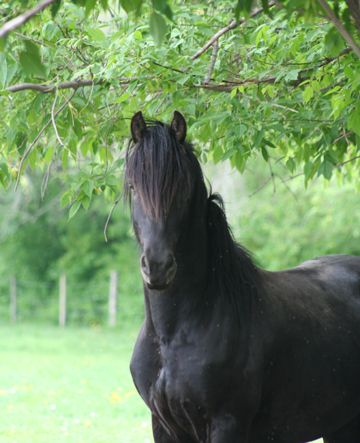
Two-year-old Friesian colt, Wagner von Donius, by Donius W of Whispering Hills Friesians in Athabasca, Alberta, shows the long, thick forelock and expressive eyes typical of the breed. Photo: Courtesy of Dawn Boyer
“There is nothing more beautiful than a Friesian that moves correctly,” says Gay Norman, General Secretary of the FPZVUSA (American Secretary to the Friesenpferde-Zuchtverband e.V.), a Germany-based Friesian registry that began in 1979, exactly 100 years after the creation of the FPS.
Related: In Praise of Percheron
But according to Friesian enthusiasts, what truly makes the breed special is its temperament.
“I don’t know any other breed that has the temperament of the Friesian,” says Steur. “They are very attached to humans.”
“They genuinely seem to love people and love to please,” says Sharp.
Both Steur and Sharp believe the breed’s connection with humans is likely due to their Dutch heritage.
“In Friesland, barns are often part of the house, and in winter large livestock — horses and cows — are kept under roof to avoid the destruction of wet pastureland. So [the Friesian’s] interactions with people has been perhaps more intense and close than other breeds,” explains Sharp.

The Friesian’s affinity with humans, willing temperament, and good work ethic make them easy to train. Photo: Robin Duncan Photography
This close affinity with humans, combined with their intelligence, makes the Friesian easy to train.
They have a good work ethic and tend to be laid back.
“If they have your trust, they will do everything for you,” says Steur. “They are really willing to work with you.”
“Their gentle personality, good heart, and eagerness to work make the Friesian horse a great horse,” says Gerben Steenbeek, who breeds Friesians at her Stonecreek Friesians in Woodham, Ontario.
“The Friesian temperament is one of the best of any breed, in my opinion,” says Norman.
“Most Friesians are very willing and really want to please.”
But, Steur warns, those new to the Friesian horse should understand that they are unique and need slightly different training than other Warmbloods. He suggests taking time to ensure both horse and rider are confident with a movement before moving on to something more difficult.
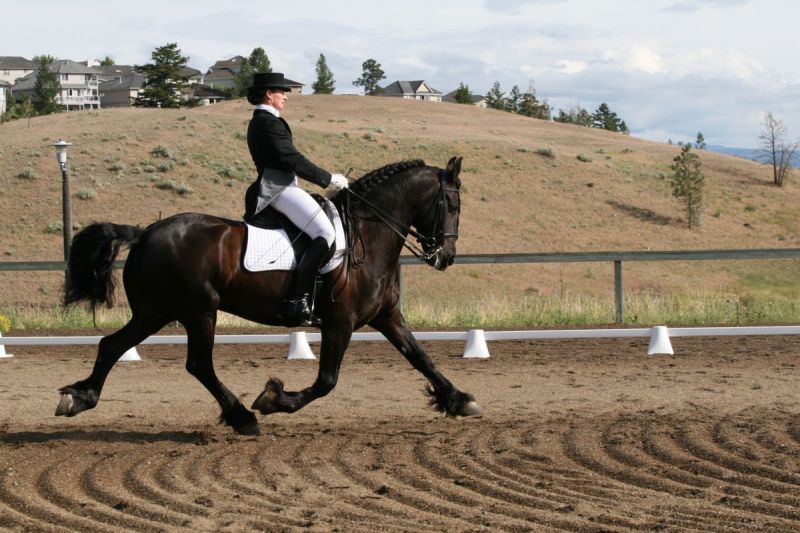
Friesians, such as this one from Endymion Farms in Vernon, BC, are making themselves known as wonderful dressage horses. Photo: Courtesy of Bonnie Derry
There is no doubt that the Friesian has increased in popularity dramatically over the past 30 years. Today there are thousands of Friesians in both Canada and the United States, including many approved stallions. In addition to the FPS, FHANA, and FPZVUSA, many other associations and registries have been created for the Friesian.
In North America, these include the Canadian Friesian Horse Association (CFHA), the International Friesian Show Horse Association (IFSHA), the Friesian Horse Society (FHS), as well as many other regional clubs.
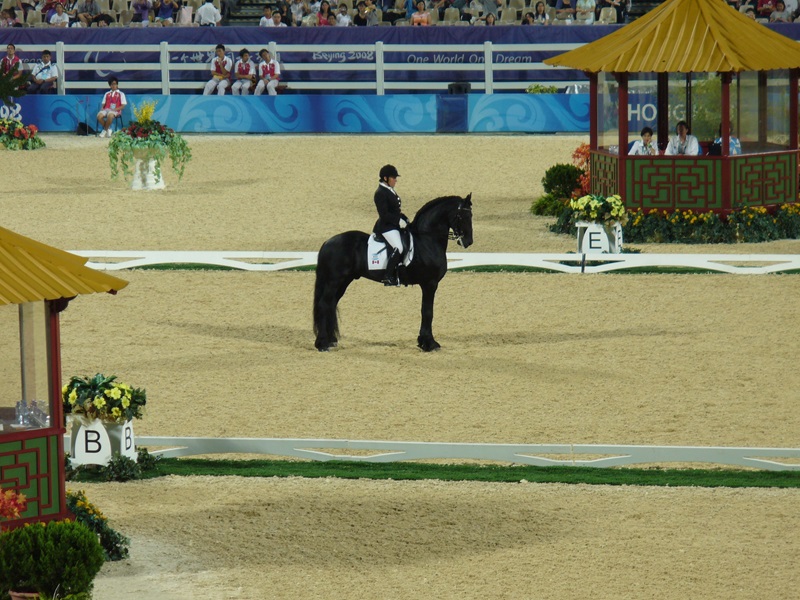
Eleonore Elstone rode Platinum Friesian’s stallion Lutke at the 2008 Paralympic Games. Photo: Courtesy of Sheila Retallick
By working under the guidance of these associations and by attending keurings or detailed inspections that rate the conformation and movement of horses, dedicated breeders are promoting and improving the breed, and it is paying off.
Friesians are becoming very popular as a family and pleasure horse, as a sport horse for dressage, and as a driving horse.
Related: The Canadian Horse
Sport type Friesians can now be seen at all levels of dressage and take part in international competitions around the globe. Canadian Paralympian Eleonore Elstone rode Lutke, a young Friesian stallion owned by Platinum Friesians of Maple Ridge, BC, at the Paralympics in Hong Kong last year. For the first time, a Friesian will be present at the World Equestrian Games in 2010, when FPS approved stallion Anders 451 will be ridden by Peter Spahn in the dressage events.

Sport type Friesians are more fine boned and athletic, and can often be seen performing dressage. Photo: Courtesy of Ron Steur
Friesians also make fine carriage horses. “The baroque type Friesian has more knee action, which people love in front of the carriage,” says Steur.
Friesians are often seen in combined driving, dressage driving, and marathon driving competitions, both in teams and alone.
They can also still be seen in front of the sjees, often performing the driven quadrille.
While Friesians are making headway as sport horses, they also make wonderful pleasure horses.
“They are a horse that the whole family can have fun with,” says Steur.
“You can want a fancy carriage horse and a trail horse, and can do it all with one horse.”
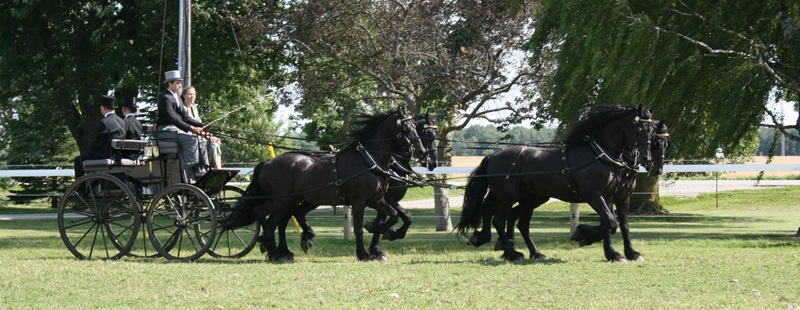
Photo: Courtesy of Gerben Steenbeek
Keurings, he says, are a fun way to learn more about the breed. “People attending (a keuring) for the first time are always impressed.”
And that impression doesn’t seem to fade even after decades. “Watching and working with the Friesian horse still takes my breath away,” says Steenbeek, who has 50 years experience with the breed.
“People are very passionate about Friesians. They know they have something very unique,” says Steur.
“I cannot imagine a life without them.”
Famous Friesians
By Melanie Huggett
With their eye-catching looks, it is not hard to see why many Friesians have been chosen to perform in Hollywood movies, where they have delighted many and inspired interest in the breed in the process.

Friesians have been performing for crowds for centuries: first as race horses, then in circuses in the mid 1900s, and now in Hollywood movies! This pair of Friesians from Endymion Farms in Vernon, BC performs a costumed pas de deux for a crowd. Photo: Courtesy of Bonnie Derry
Perhaps the most famous Friesian on the silver screen is the stallion Othello, who starred alongside Holland’s Rutger Hauer, Michelle Pfeiffer, and Matthew Broderick in the 1985 film Ladyhawke, where he played “Goliath.” Othello was a circus performer for his owner Manuela Beeloo. The stallion’s performance in Ladyhawke is credited with helping to increase the popularity of the breed in North America.
Friesians can also be seen in the movies The Mask of Zorro, Alexander, Sense and Sensibility, Emma, Interview with a Vampire, The Chronicles of Narnia, and 300, among others.
Related: A Carriage Ride Through History
Related: The Icelandic Horse - An Island Treasure
Main photo: Friesians make wonderful carriage horses for pleasure or competitive driving. Here, Gerben Steenbeek of Stonecreek Friesians drives a pair of purebred Friesian geldings through a cones pattern. Courtesy of Gerben Steenbeek
The references in this article are relevant to the time it was originally published in 2012.



